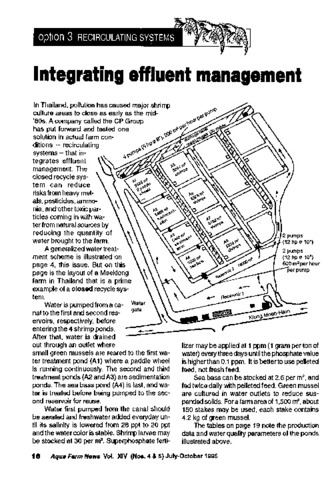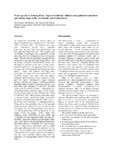Shrimp pond effluents and water quality in Imbang River, Negros Occidental
- Global styles
- MLA
- Vancouver
- Elsevier - Harvard
- APA
- Help

View/Open
Date
2007Author
Page views
4,117ASFA keyword
AGROVOC keyword
Metadata
Perlihat publikasi penuhShare
Abstract
The contribution of shrimp farm effluents to the pollution load in Imbang River, Negros Occidental was measured during the period May 1993 to February 1995. Shrimp pond effluents were characterized and the pollution load estimated. The pond effluents had low average nitrite (0.0025 ppm) and nitrate (0.06 ppm) and optimum (for shrimp culture) pH 7.9, phosphate 0.15 ppm, dissolved oxygen 5.20 ppm, and salinity 23.3 ppt. Ammonia was 0.13 ppm on average in most farms, above the safe level for shrimp, and total suspended solids was 23 ppm, about 2.5x the allowed limit for effluents. Biochemical oxygen demand (20 ppm) and settleable solids (0.15 ppm) were still with acceptable limits. Residues of organochlorine pesticides were present at very low concentrations, well below the safe levels for aquatic life. Most of the pollution load came from the regular water exchanges over the 4-month crop cycle, at least every two weeks in low-density farms and more frequently in the high-density farms. The total draining of pond water at harvest contributed a minor load. Total solids from shrimp farms contributed a huge load, about 181,325 mt/yr. Total suspended solids contributed 1,285 mt/yr and settleable solids <1 mt/yr. The total BOD load was 154,367 kg/yr. The phosphate load was about 1,080 kg/yr, and the total nitrogen load was 1,225 kg/yr. The effects of effluent release from farms were localized. Upstream water quality and other uses of the river were not affected. Since most of the shrimp farms were located 1.5–2 km from the sea, the release of effluents during water exchange and at harvest did not adversely affect water quality downstream of these farms. Where such draining increased the levels of ammonia, phosphate, and total suspended solids in the river, the effect was significant only within 250 m from the release point, and the pollutants were dissipated about 550–800 m downstream The other water quality variables were at low levels in the pond effluents and did not affect the river water during draining. Often the concentrations of pollutants in the river were higher before than during draining of pond effluents. Stations upstream of the release sites of pond effluents often had high pollutant concentrations from other upstream sources.
Suggested Citation
Taberna, E. T. (2008). Shrimp pond effluents and water quality in Imbang River, Negros Occidental. In T. U. Bagarinao (Ed.), Research Output of the Fisheries Sector Program (Vol. 2. Reports on Fisheries and Aquaculture, pp. 60-70). Quezon City, Philippines: Bureau of Agricultural Research, Department of Agriculture.
Type
Book chapterISBN
9718511776
Related items
Showing items related by title, author, creator and subject.
-
Current status, issues, and gaps on aquatic emergency preparedness and response systems practiced by Cambodia
Khan, Chan Dara; Chhorn, Sokleang; Thay, Somony (Aquaculture Department, Southeast Asian Fisheries Development Center, 2019)A few decades ago, Cambodia was rich in both freshwater and marine fisheries resources because of its favorable geographical area. However, the fisheries resources have depleted and were unable to totally fulfill the ... -
Integrating effluent management
Southeast Asian Fisheries Development Center, Aquaculture Department (Aquaculture Department, Southeast Asian Fisheries Development Center, 1996)The paper discusses a closed recycle shrimp farm in Thailand which integrates effluent management. The closed recycle system can reduce risk of heavy metals, pesticides, ammonia, and other toxic particles coming in with ... -
Water quality in Imbang river, Negros Occidental: effluents and pollutant loads from agriculture, sugar mills, households, and shrimp farms
Gonzales, Guadiosa A.; Gonzales, Hernane J.; Sanares, Roman C.; Taberna, Evelyn T. (Bureau of Agricultural Research, Department of Agriculture, 2007)An ecological assessment of Imbang River in Negros Occidental was undertaken from December 1992 to February 1995. The effluents from sugar mills, households, shrimp farms, sugarcane plantations and rice fields were ...




